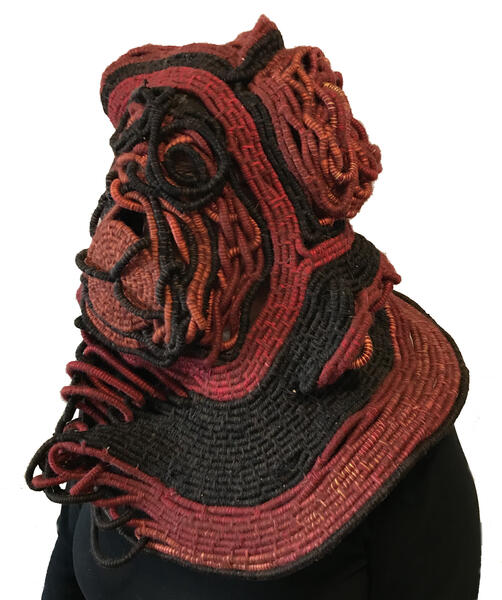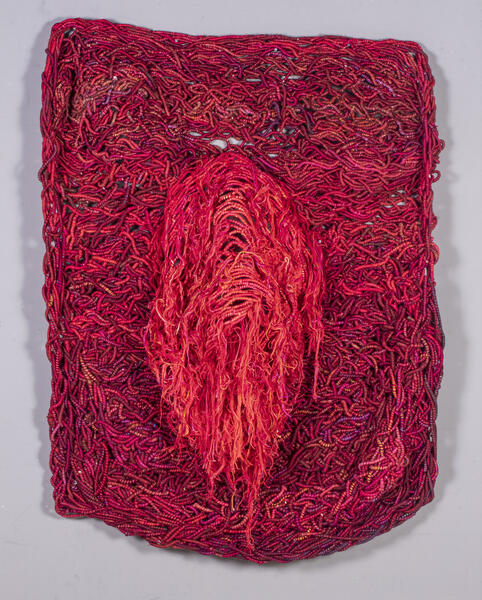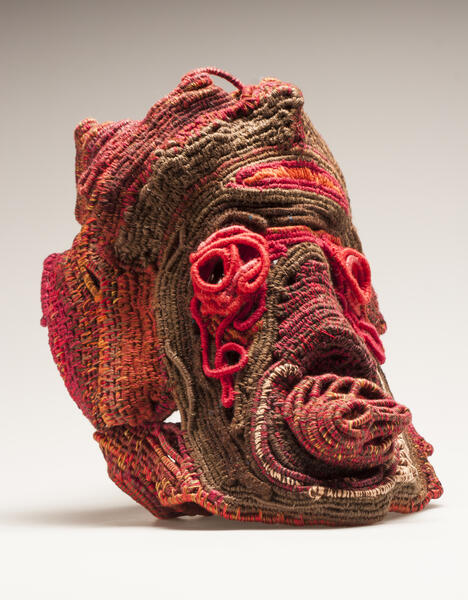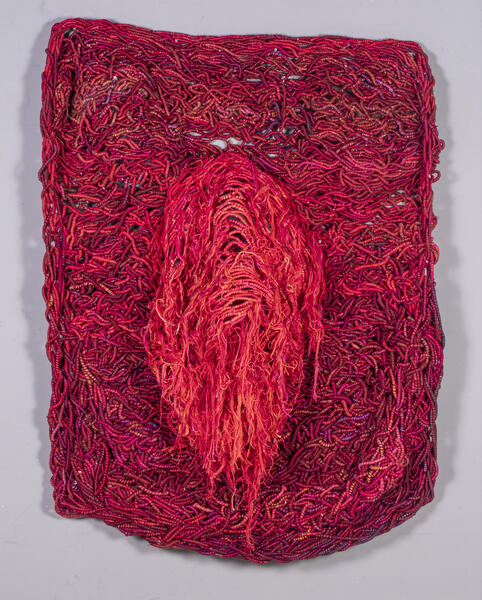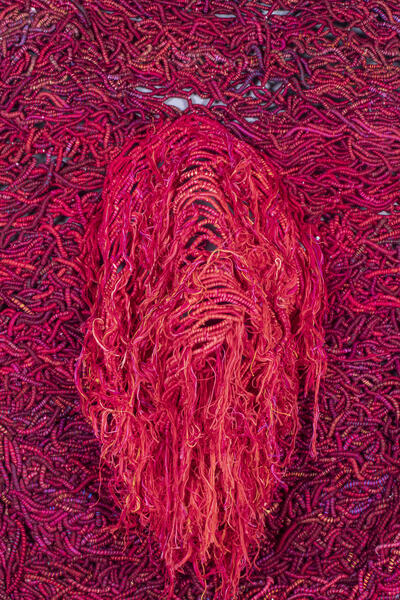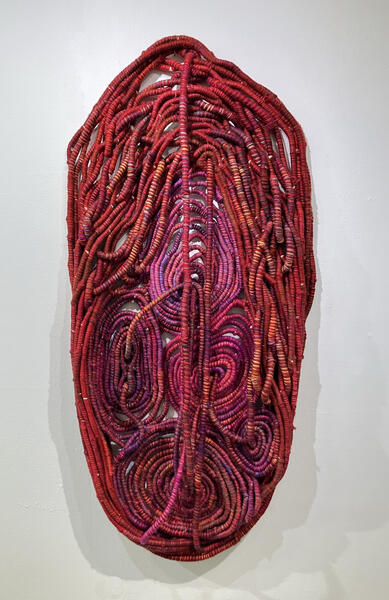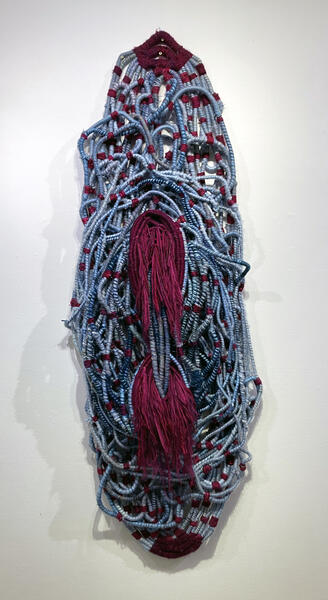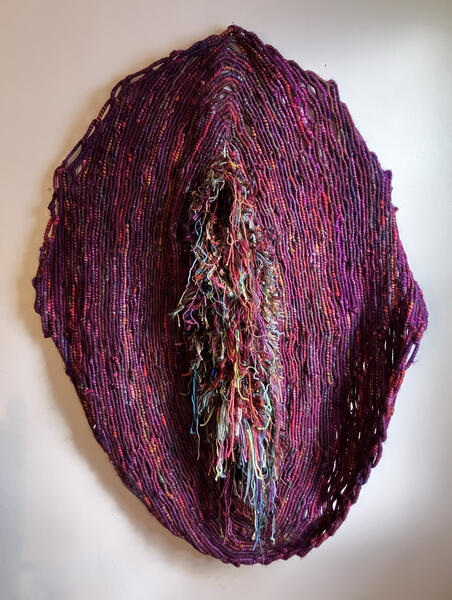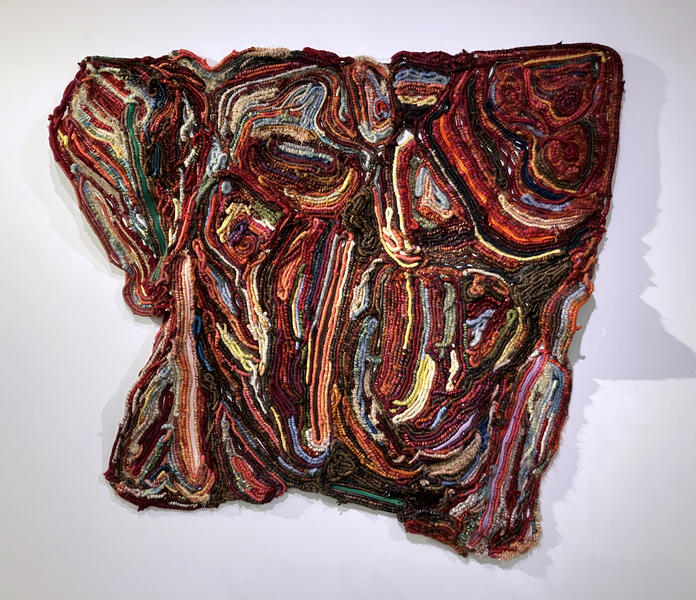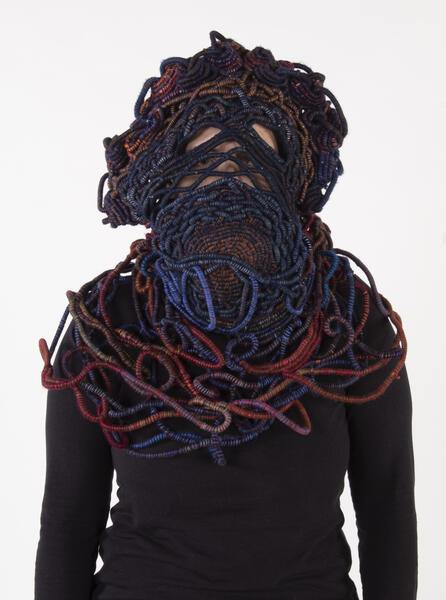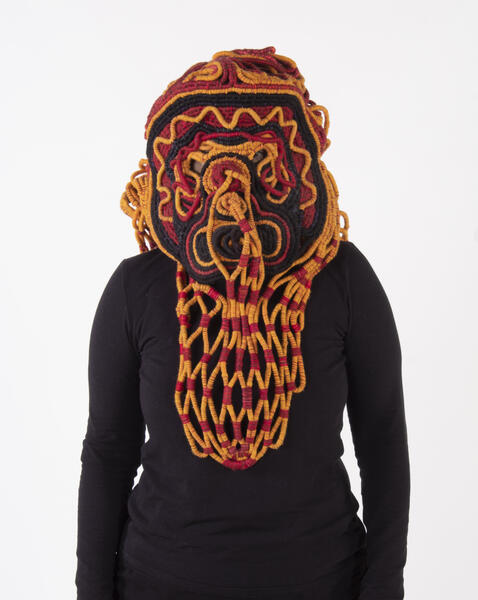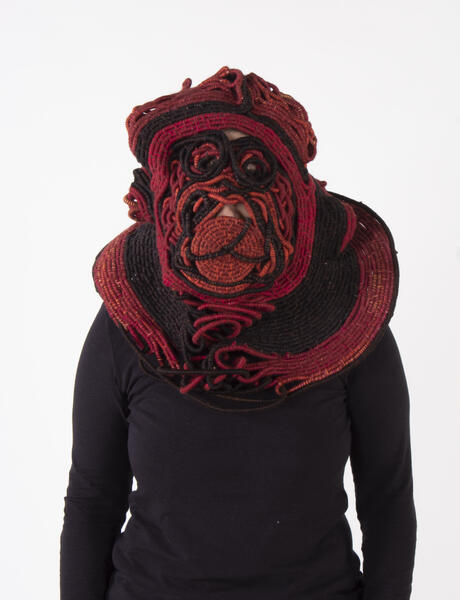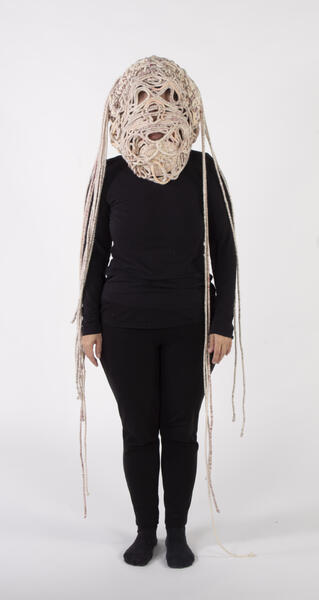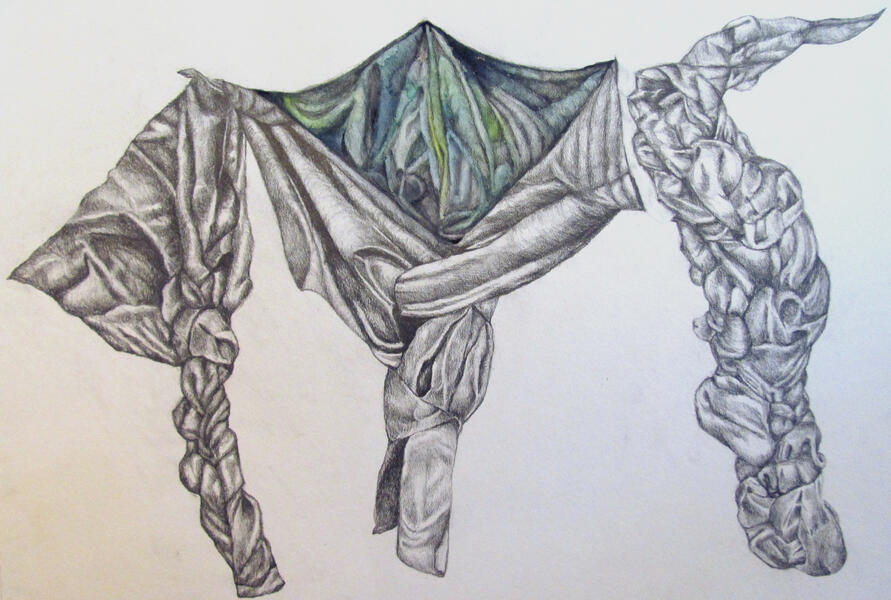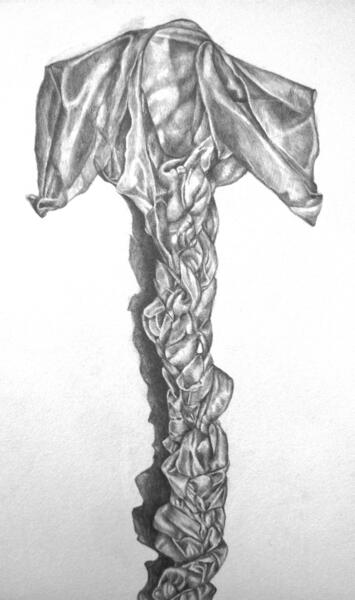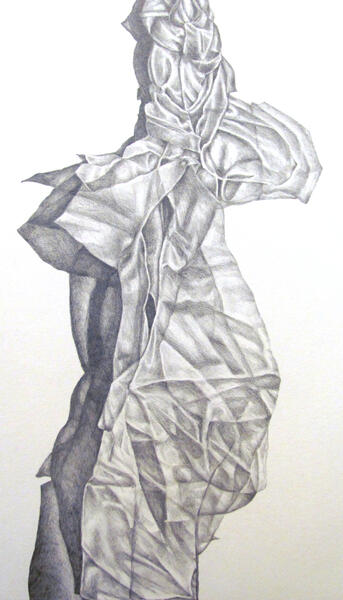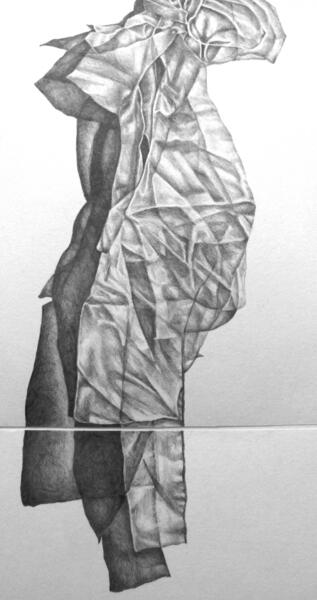About Jessica
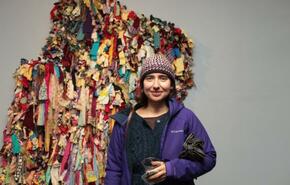
Jessica Walton (Baltimore, MD) is a fiber and mixed media artist whose work is inspired by a love of art history, archaeology, psychology, process, material, and the human body. Her current body of work includes a series of sculptural works using a traditional basketry technique called coiling. Her work has been exhibited nationally including at the Delaware Art Museum and Kent State University Museum. In 2017 she was a Sondheim Semifinalist in her hometown of Baltimore, Maryland. In… more
Womb Series
These large wall hangings were created using a basketry technique called coiling. The process of making these works, like many traditional fiber techniques, is repetitive and labor intensive. I started making this series after Roe V. Wade was overturned by the supreme court. Although the work is meant to be abstract, anger and frustration relating to this event were on my mind while creating this work. In addition, these works explore my complex relationship with motherhood and the complexities of birthing a child in mind and body. They also explore emotional complexities and the hidden and revealed sides of self.
Coiled Masks
These masks are made using a basketry technique called coiling. The process of making these works, like many traditional fiber techniques, is repetitive and labor intensive. I enjoy the meditative process of wrapping, building up forms thread by thread in an intuitive way.
These works are inspired by mask making traditions from around the world. Masks conceal and reveal identity. They allow their wearers freedom to hide and space to explore new versions of themselves. They are theatrical, playful, multi-colored and often grotesque. These works explore multiple identities, veiling and revealing hybrid beings.
-
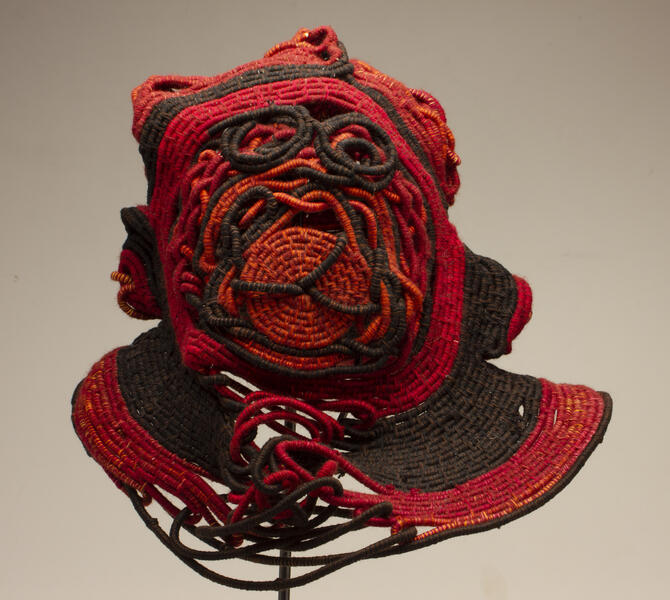 Coiled Mask 3, thread and rope, 2020, 24 x 13 x 16Coiled Mask 3, thread and rope, 2020, 24 x 13 x 16
Coiled Mask 3, thread and rope, 2020, 24 x 13 x 16Coiled Mask 3, thread and rope, 2020, 24 x 13 x 16 -
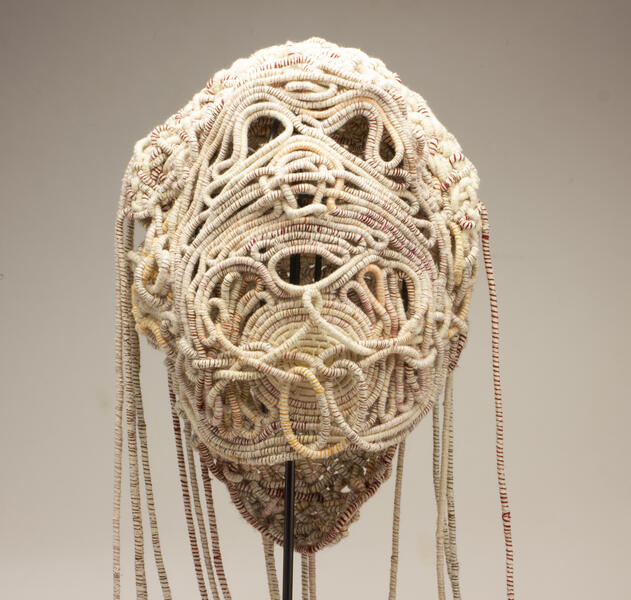 Coiled Mask 4Coiled Mask 4, thread and rope, 2021, 60 x 15 x 11 inches
Coiled Mask 4Coiled Mask 4, thread and rope, 2021, 60 x 15 x 11 inches -
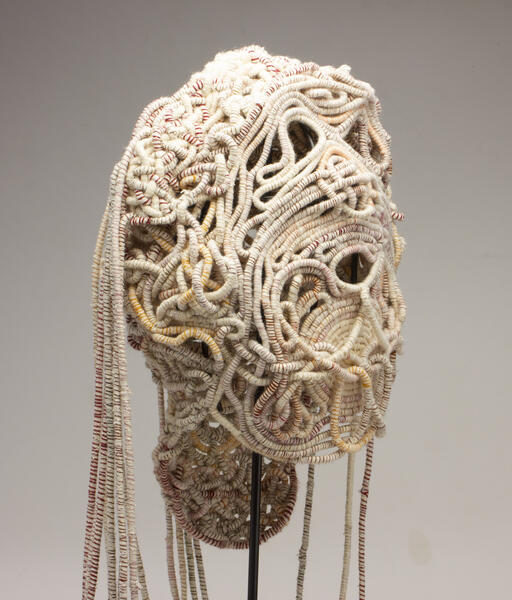 Coiled Mask 4Coiled Mask 4 (profile), thread and rope, 2021, 60 x 15 x 11 inches
Coiled Mask 4Coiled Mask 4 (profile), thread and rope, 2021, 60 x 15 x 11 inches -
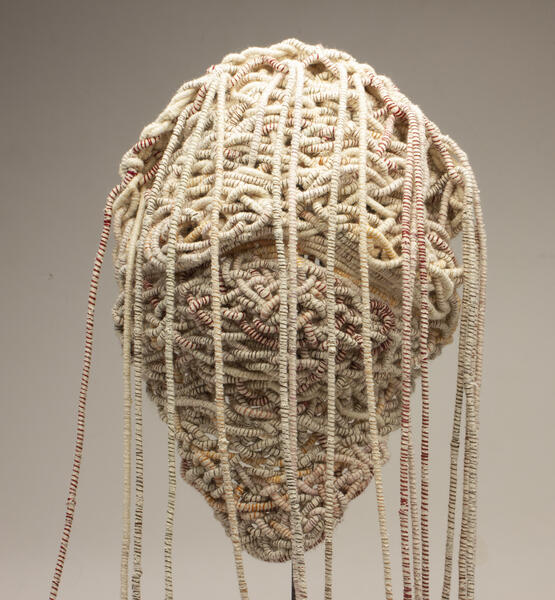 Coiled Mask 4 ( back)Coiled Mask 4 (back), thread and rope, 2021, 60 x 15 x 11 inches
Coiled Mask 4 ( back)Coiled Mask 4 (back), thread and rope, 2021, 60 x 15 x 11 inches -
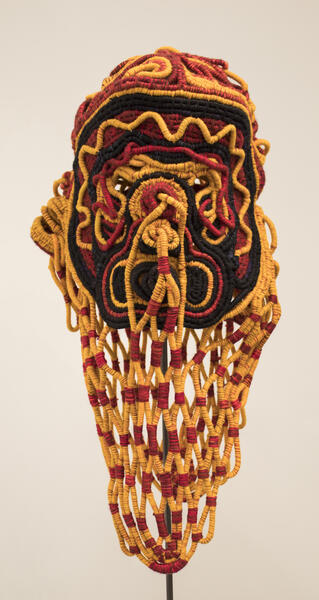 Coiled Maskthread and rope, 2018, 24 x 12 x 8 inches
Coiled Maskthread and rope, 2018, 24 x 12 x 8 inches -
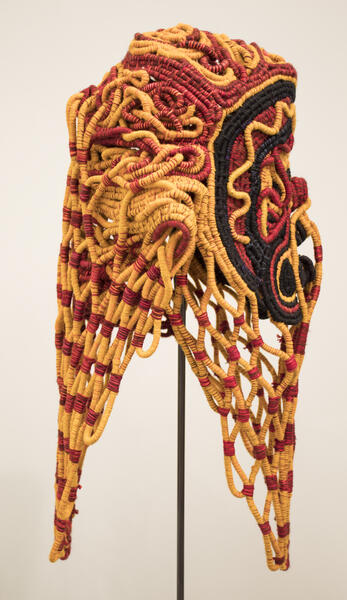 Coiled Mask Profile 2thread and rope, 2018, 24 x 12 x 8 inches
Coiled Mask Profile 2thread and rope, 2018, 24 x 12 x 8 inches -
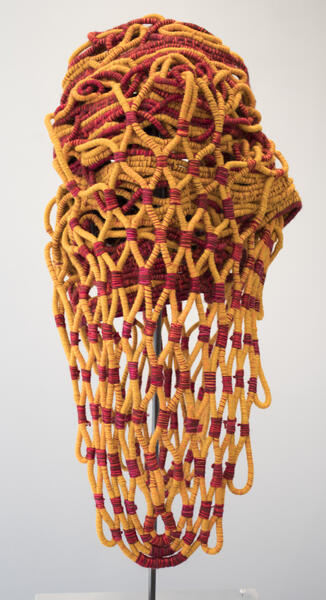 Coiled Mask Reversethread and rope, 2018, 24 x 12 x 8 inches
Coiled Mask Reversethread and rope, 2018, 24 x 12 x 8 inches -
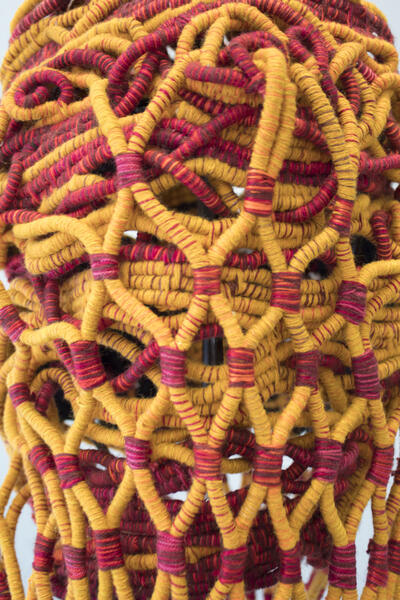 Coiled Mask Detailthread and rope, 2018, 24 x 12 x 8 inches
Coiled Mask Detailthread and rope, 2018, 24 x 12 x 8 inches -
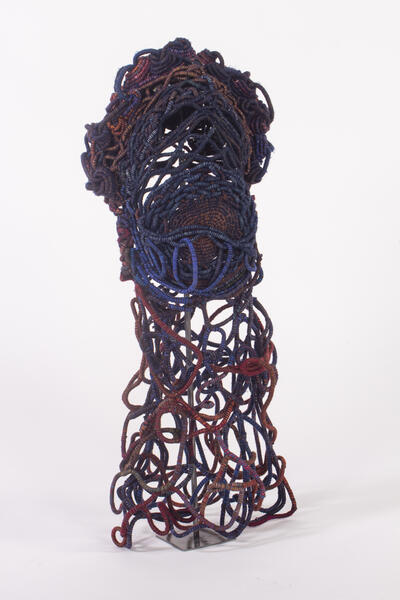 Coiled Mask 5
Coiled Mask 5Jessica Walton, Coiled Mask 5, 2024, thread and rope
-
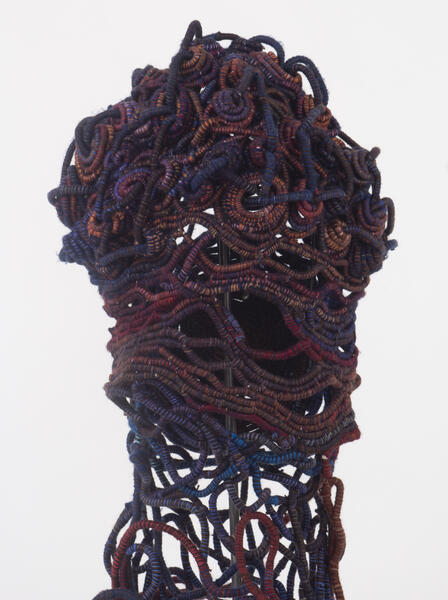 Coiled Mask 5
Coiled Mask 5Jessica Walton, Coiled Mask 5 (detail, reverse), 2024
Coiled Heads
These works are inspired by mask making traditions from around the world. Masks conceal and reveal identity. They allow their wearers freedom to hide and space to explore new versions of themselves. They are theatrical, playful, multi-colored and often grotesque. Like masks, these works explore multiple identities, veiling and revealing hybrid beings.
-
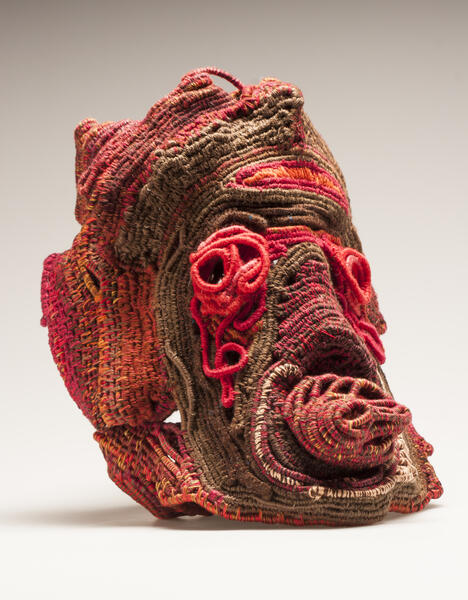 up, over, pull throughthread and rope, 2014, 13" x 10" x 10"
up, over, pull throughthread and rope, 2014, 13" x 10" x 10" -
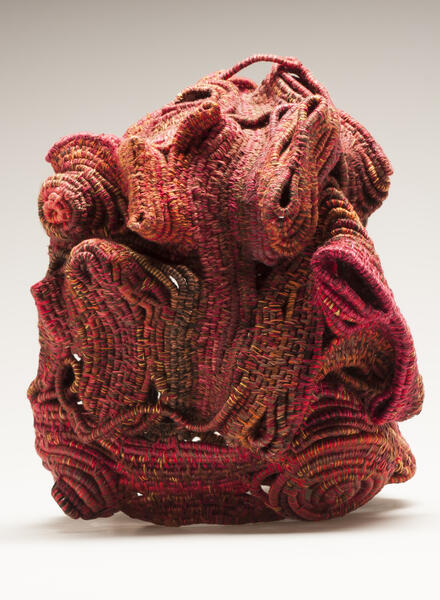 up, over, pull through (back)thread and rope, 2014, 13" x 10" x 10"
up, over, pull through (back)thread and rope, 2014, 13" x 10" x 10" -
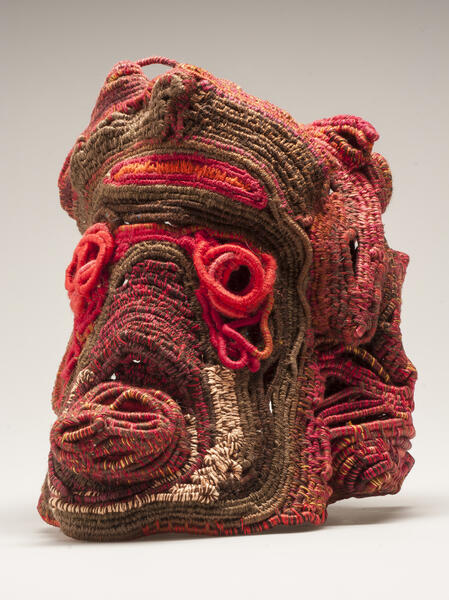 up, over, pull throughthread and rope, 2014, 13" x 10" x 10"
up, over, pull throughthread and rope, 2014, 13" x 10" x 10" -
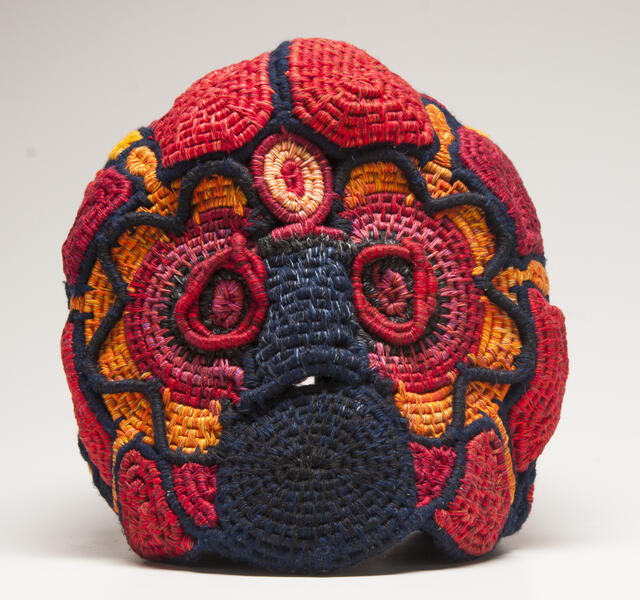 Coiled Head 1thread and rope, 2016, 14 x 14 x 10 inches
Coiled Head 1thread and rope, 2016, 14 x 14 x 10 inches -
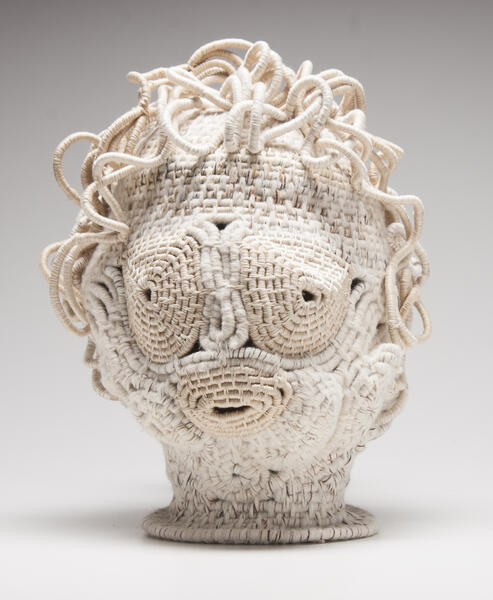 Coiled Head 2thread and rope, 2015, 15 x 13 x 12 inches
Coiled Head 2thread and rope, 2015, 15 x 13 x 12 inches -
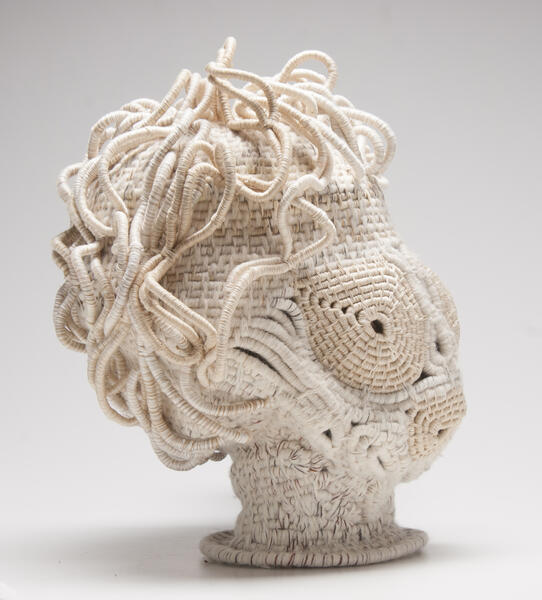 Walton_coiled_head_3.jpg
Walton_coiled_head_3.jpg -
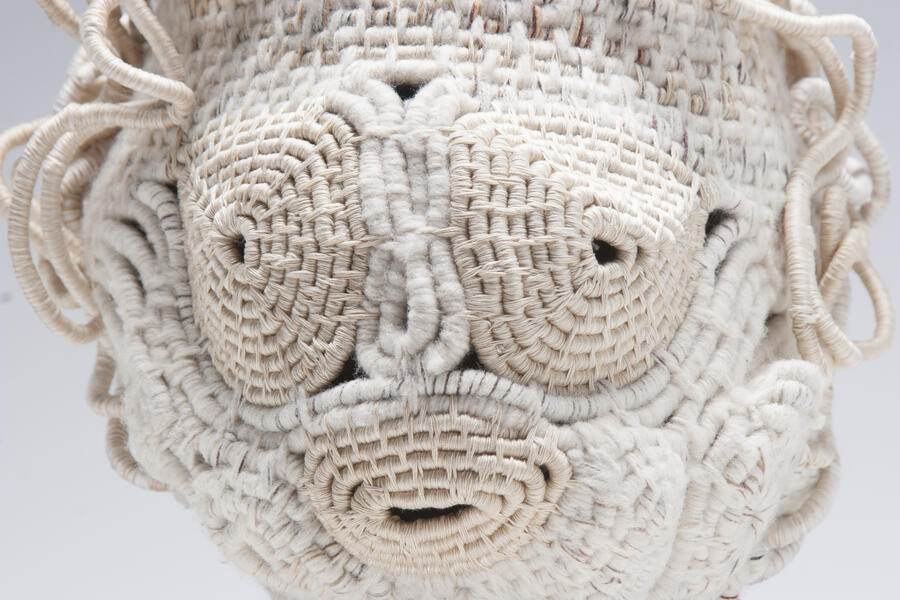 Coiled Head 2 Detailthread and rope, 2015, 15 x 13 x 12 inches
Coiled Head 2 Detailthread and rope, 2015, 15 x 13 x 12 inches -
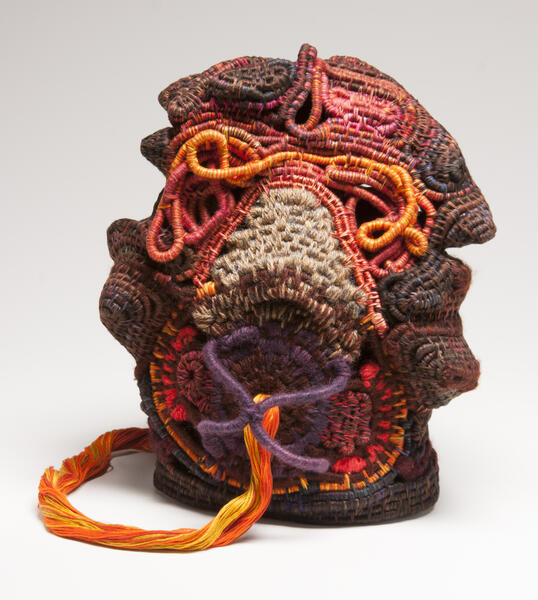 Coiled Head 3 (front)rope and thread, 2015, 12 x 10 x 10 inches
Coiled Head 3 (front)rope and thread, 2015, 12 x 10 x 10 inches -
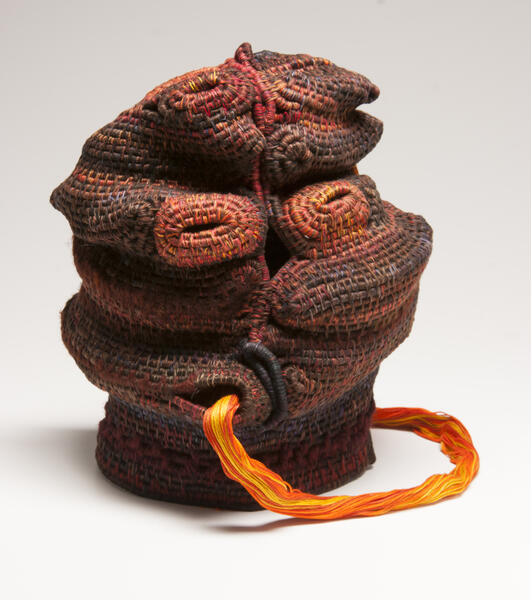 Coiled Head 3 (reverse)rope and thread, 2015, 12 x 10 x 10 inches
Coiled Head 3 (reverse)rope and thread, 2015, 12 x 10 x 10 inches
Remnants Series
The fabrics used in these works come from many different sources. There are pieces of material in them that I have lived with my entire life. Many fabric pieces were kindly donated to me by friends and family. Other pieces were once worn, discarded, and now repurposed.
The process of making these works, like many traditional fiber techniques, is repetitive and labor intensive. I enjoy the real or imagined memories associated with each piece of fabric in these works. The tactile process of cutting and sewing the pieces of fabric brings together an accumulation of material, memory, and labor.
The Remnants Reimagined work was installed for the show "Goodwill" curated by Sarada Conaway in the Gallery at CCBC Catonsville.
The Remnant dress was made for the show "Ordinary Woman", curated by Diana Marta at the Howard County Arts Center and later installed at the gallery at CCBC Essex's inaugural exhibition "Dedication".
-
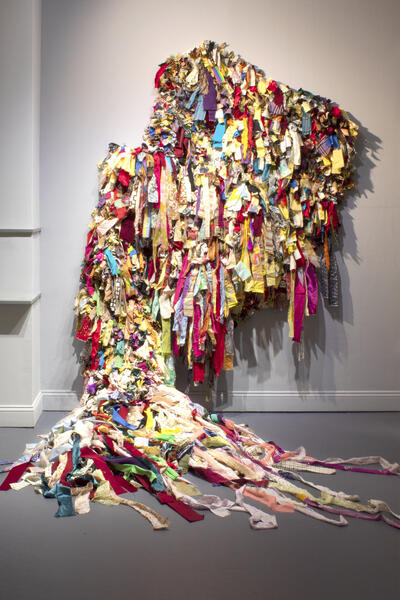 Remnants ReimaginedInstallation for "Goodwill" exhibition curated by Sarada Conaway, 2018, fabric, 8 ft x 6 ft x 6 ft
Remnants ReimaginedInstallation for "Goodwill" exhibition curated by Sarada Conaway, 2018, fabric, 8 ft x 6 ft x 6 ft -
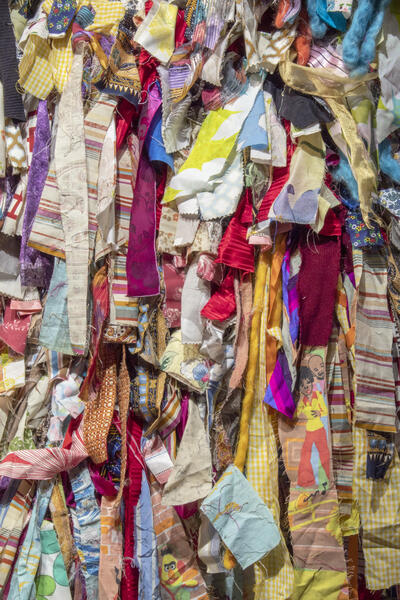 Remnants Reimagined detail
Remnants Reimagined detail -
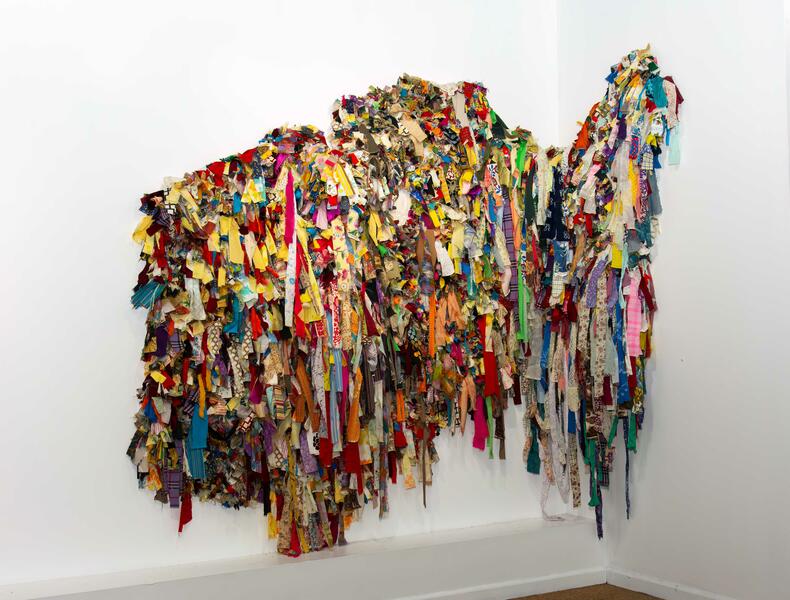 Remnants Installed at Gallery 220
Remnants Installed at Gallery 220This is a newer installation of the work from 2024 at the exhibition Threaded at Gallery 220 in Havre De Grace, Md.
-
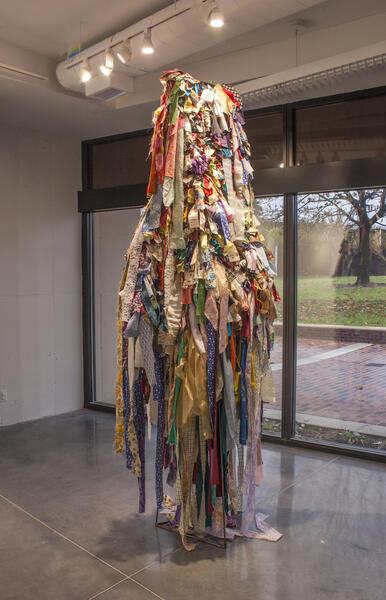 Remants2014 fabric and thread Installation at the Gallery at CCBC Essex
Remants2014 fabric and thread Installation at the Gallery at CCBC Essex -
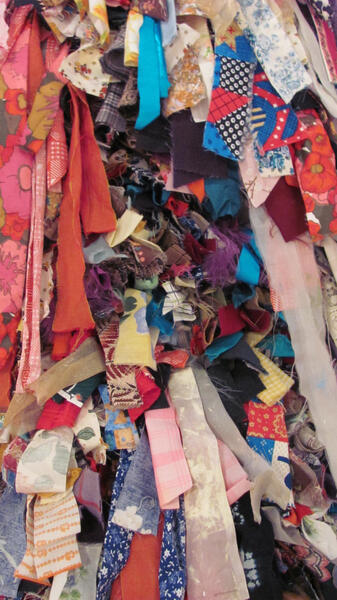 Remnant Dress (detail 1)Fabric 2014 7 ft x 4 ft at full height
Remnant Dress (detail 1)Fabric 2014 7 ft x 4 ft at full height -
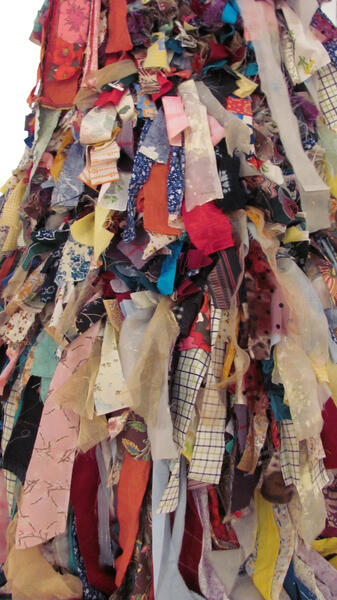 Remnant Dress (Detail 2)Fabric 2014 7 ft x 4 ft at full height
Remnant Dress (Detail 2)Fabric 2014 7 ft x 4 ft at full height -
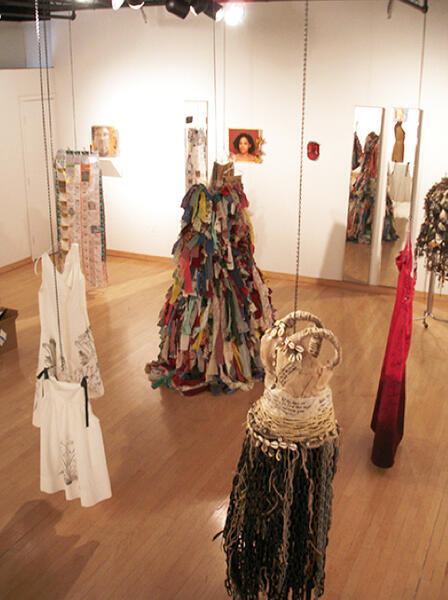 Installation shot of Ordinary Woman Show at the Howard County Arts CenterHere is the dress in a group exhibition entitled "Ordinary Woman" curated by Diana Marta at the Howard County Center for the Arts
Installation shot of Ordinary Woman Show at the Howard County Arts CenterHere is the dress in a group exhibition entitled "Ordinary Woman" curated by Diana Marta at the Howard County Center for the Arts -
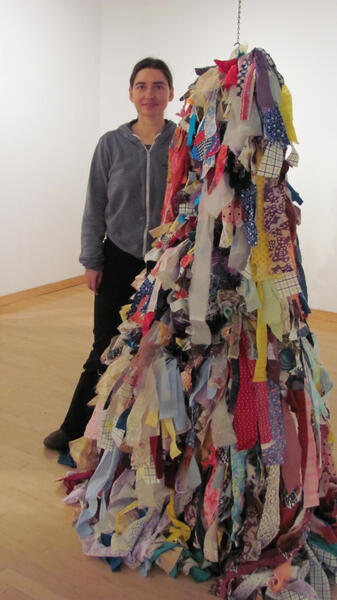 Me with Remnants installed at Howard County Arts CenterHere is the dress in a group exhibition entitled "Ordinary Woman" curated by Diana Marta at the Howard County Center for the Arts
Me with Remnants installed at Howard County Arts CenterHere is the dress in a group exhibition entitled "Ordinary Woman" curated by Diana Marta at the Howard County Center for the Arts -
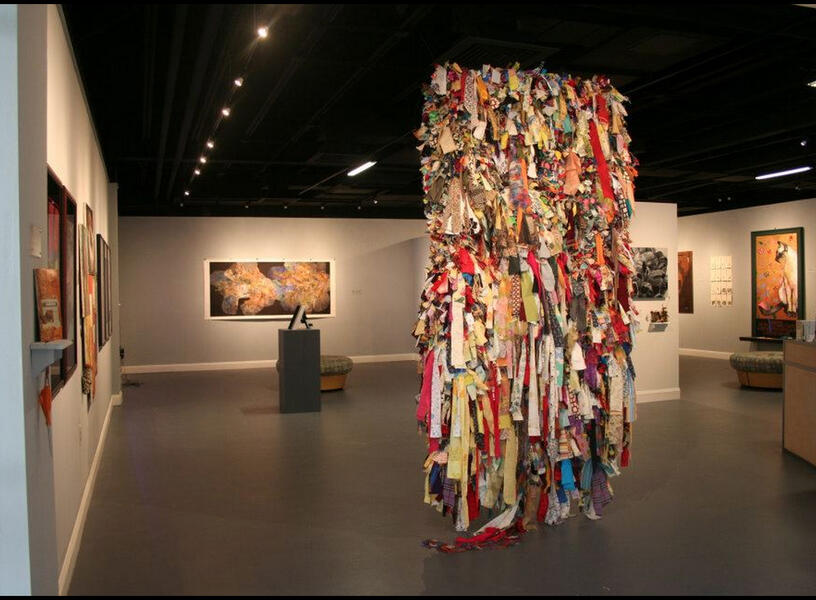 Remnants Hangingfabric and thread Installation view at CCBC Catonsville Gallery 9 ft x 5 ft 2013
Remnants Hangingfabric and thread Installation view at CCBC Catonsville Gallery 9 ft x 5 ft 2013 -
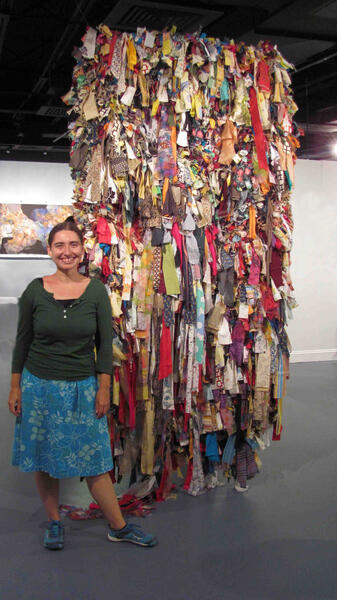 Remnants Hangingfabric and thread Installation view at CCBC Catonsville Gallery 9 ft x 5 ft 2013
Remnants Hangingfabric and thread Installation view at CCBC Catonsville Gallery 9 ft x 5 ft 2013
Layered Figure Drawings
I am interested in the psychological and physical relationships that form between these many versions of the body. Are these loving or violent, perverse or celebratory?
-
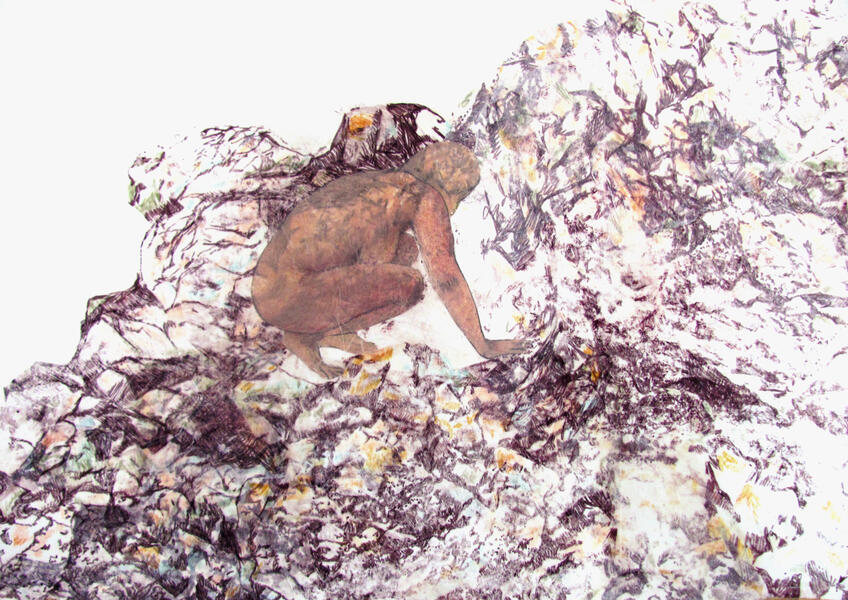 Opening (detail 2)mixed media on canvas 2012 7 ft x 4 ft
Opening (detail 2)mixed media on canvas 2012 7 ft x 4 ft -
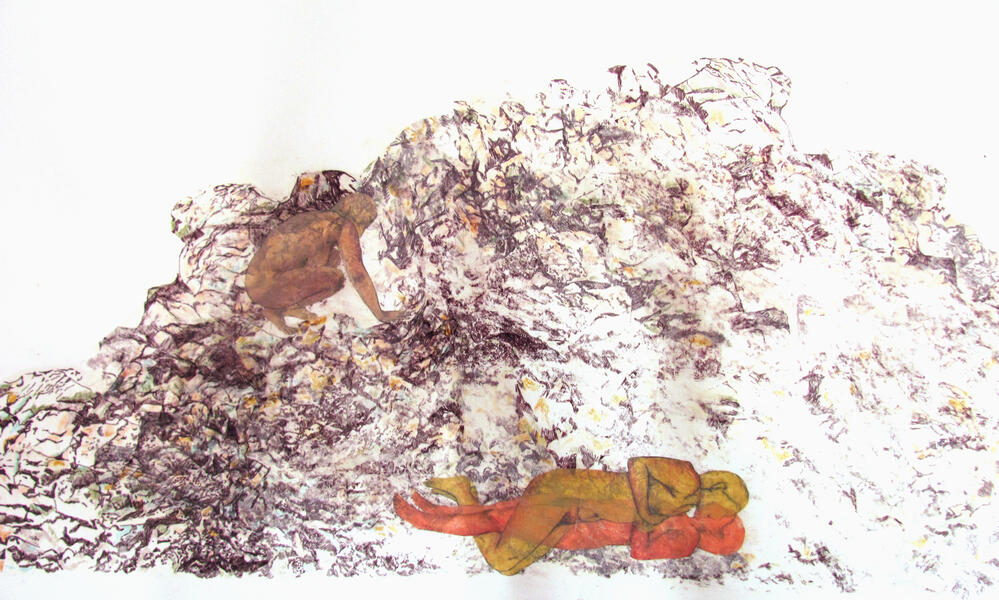 Opening (detail)mixed media on canvas 2012 7 ft x 4 ft
Opening (detail)mixed media on canvas 2012 7 ft x 4 ft -
 Reach 2 (detail)detail of larger hanging scroll 8 ft x 1 ft mixed media on paper 2012
Reach 2 (detail)detail of larger hanging scroll 8 ft x 1 ft mixed media on paper 2012 -
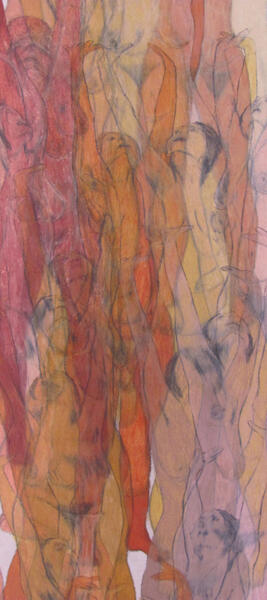 Reach 2 (detail)detail of larger hanging scroll 8 ft x 1 ft mixed media on paper 2012
Reach 2 (detail)detail of larger hanging scroll 8 ft x 1 ft mixed media on paper 2012 -
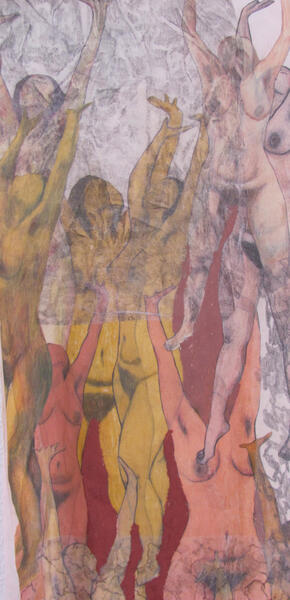 Reach (detail)detail of larger hanging scroll 8 ft x 1 ft mixed media on paper 2012
Reach (detail)detail of larger hanging scroll 8 ft x 1 ft mixed media on paper 2012 -
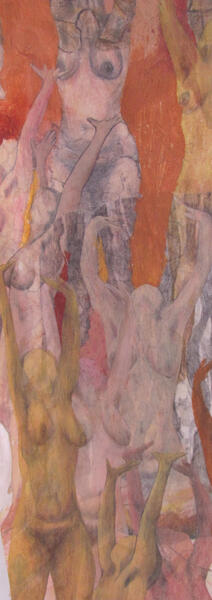 Reach (detail)detail of larger hanging scroll 8 ft x 1 ft mixed media on paper 2012
Reach (detail)detail of larger hanging scroll 8 ft x 1 ft mixed media on paper 2012 -
 scrollmixed media on paper 2011 36 inches x 8 inches
scrollmixed media on paper 2011 36 inches x 8 inches -
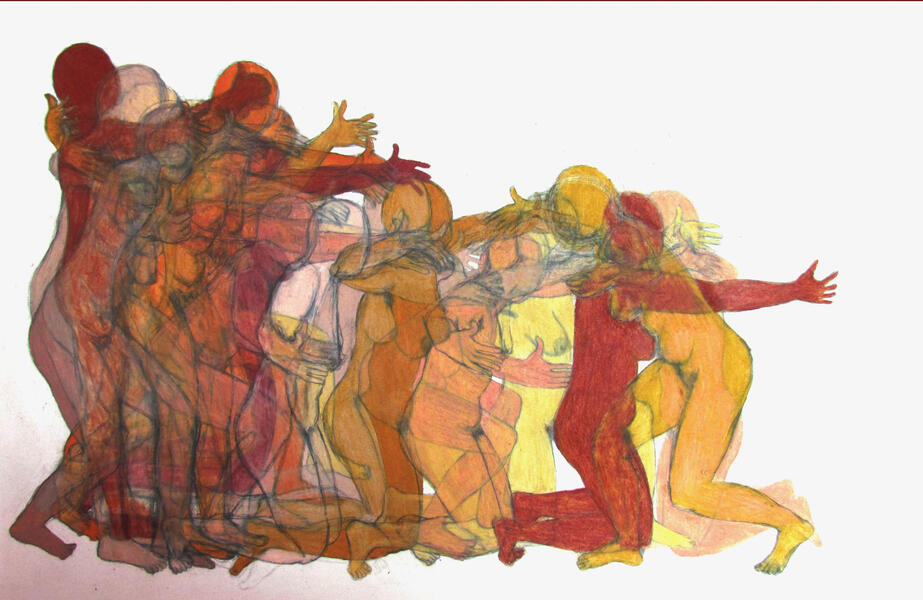 Flowmixed media on paper 3 ft x 2 ft 2011
Flowmixed media on paper 3 ft x 2 ft 2011 -
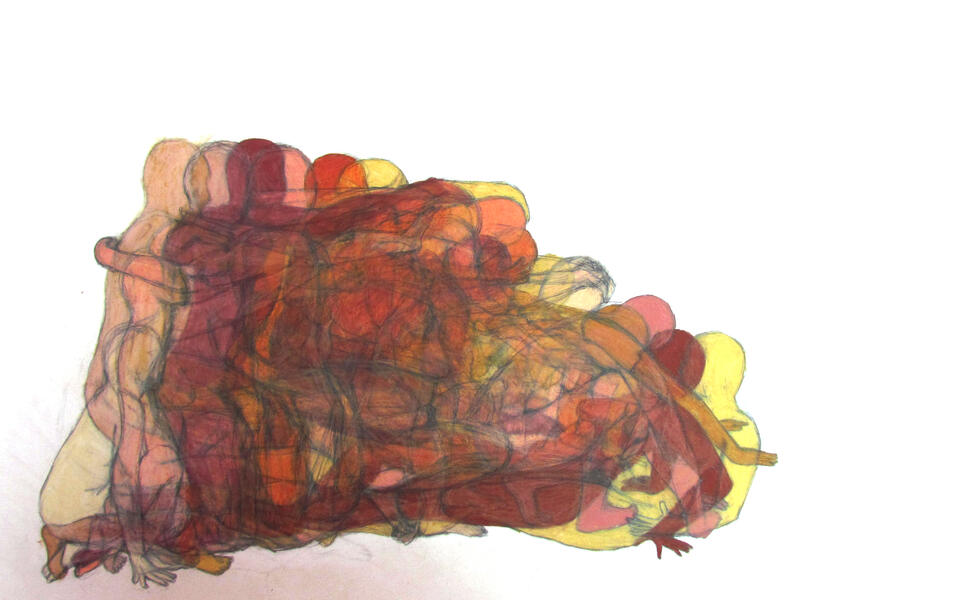 Fluxmixed media on paper 3 ft x 2 ft 2011
Fluxmixed media on paper 3 ft x 2 ft 2011 -
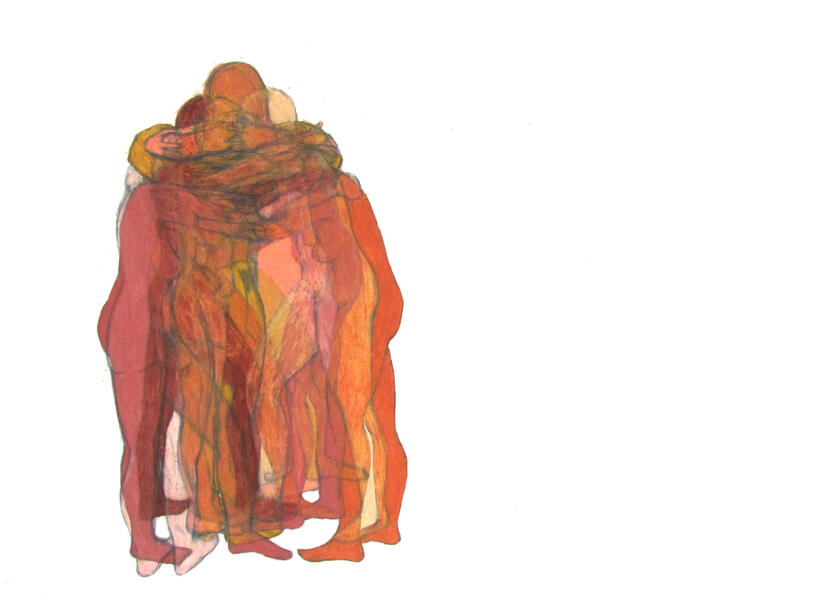 Huddlemixed media on paper 2011 3 ft x 2 ft
Huddlemixed media on paper 2011 3 ft x 2 ft
A Mythology of Anatomy
-
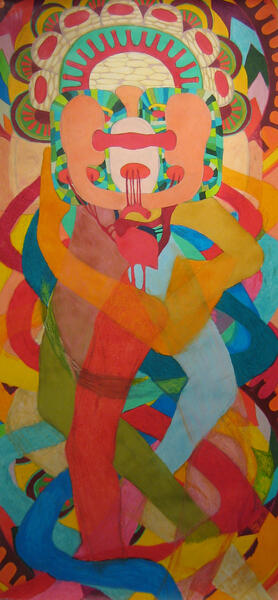 A body with in betweenmixed media on paper 2008 7 ft x 3 ft
A body with in betweenmixed media on paper 2008 7 ft x 3 ft -
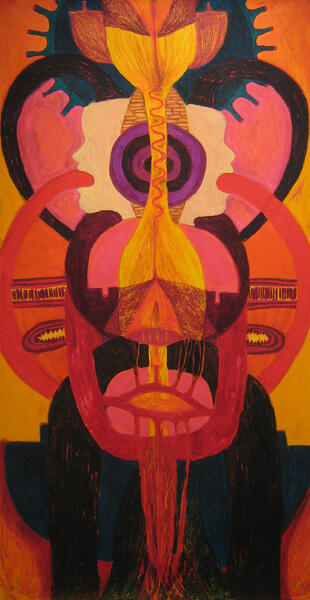 Red bone and twisted thingsMixed media on paper 2008 7 ft x 3 ft
Red bone and twisted thingsMixed media on paper 2008 7 ft x 3 ft -
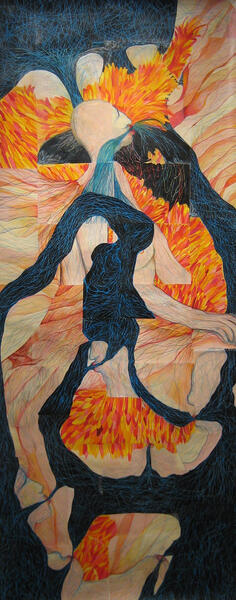 Flowing in and out ofMixed media on paper 7 ft x 3 ft 2008
Flowing in and out ofMixed media on paper 7 ft x 3 ft 2008 -
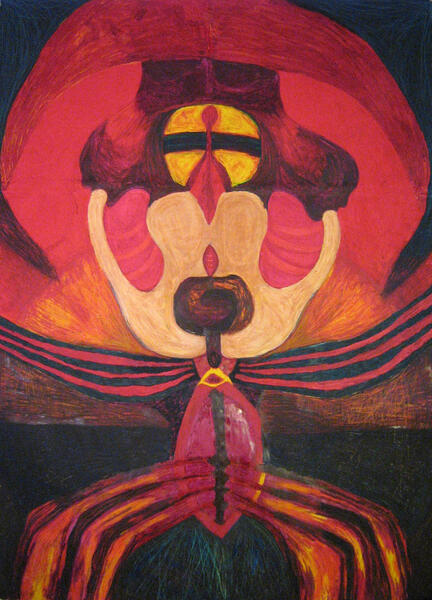 Chimeramixed media on paper 2008 10 ft x 6 ft
Chimeramixed media on paper 2008 10 ft x 6 ft -
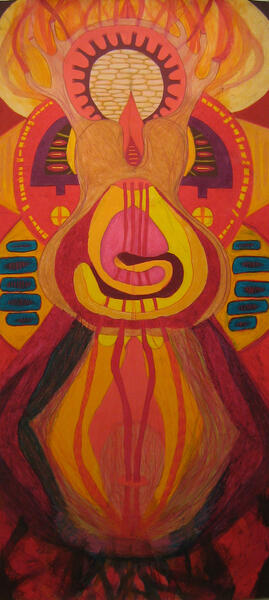 A body undonemixed media on paper 2008 7 ft x 3 ft
A body undonemixed media on paper 2008 7 ft x 3 ft -
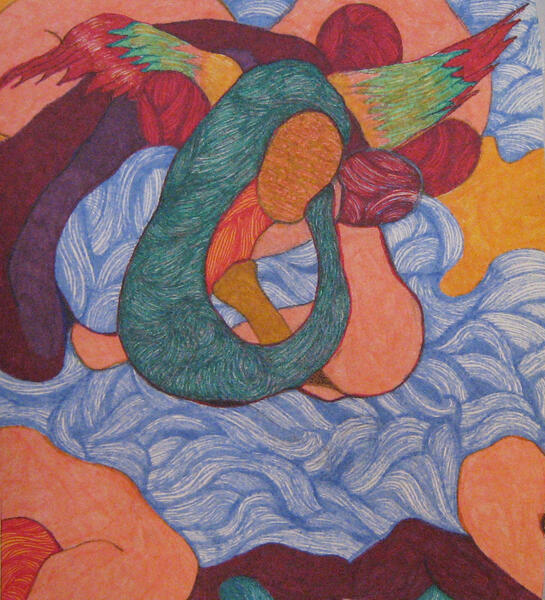 anamesa oneink on paper 2008 10 inches x 10 inches
anamesa oneink on paper 2008 10 inches x 10 inches -
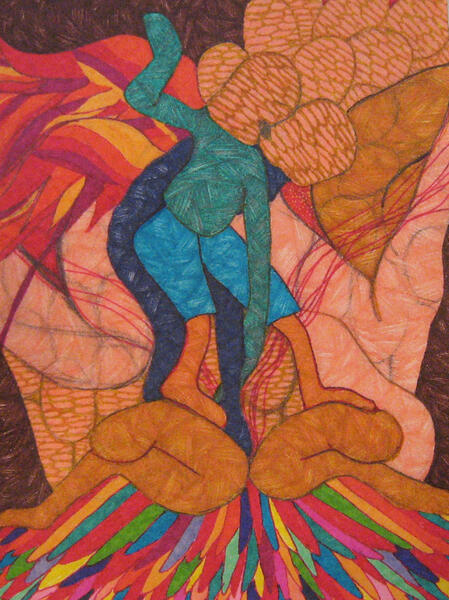 anamesa 2ink on paper 2008 10 inches x 10 inches
anamesa 2ink on paper 2008 10 inches x 10 inches -
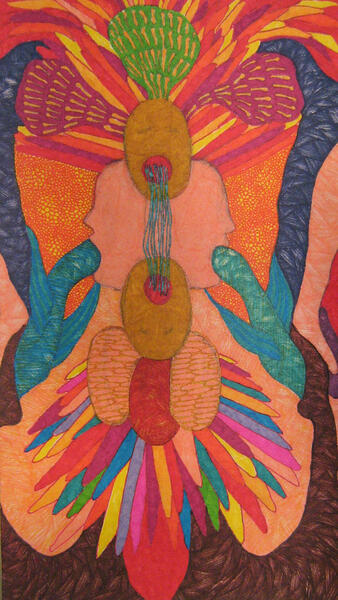 Anamesa 3ink on paper 2008 10 inches x 5 inches
Anamesa 3ink on paper 2008 10 inches x 5 inches -
 A Mythology of AnatomyInstallation View at CCBC Dundalk Gallery
A Mythology of AnatomyInstallation View at CCBC Dundalk Gallery
Graphite Drawings of Fabric Constructions
Graduate Work - Mount Royal School of Art - MICA
Many of these concerns are deeply rooted in the ideas raised in Donna Haraway’s “ A Manifesto for Cyborgs: Science, Technology, and Socialist Feminism in the 1980’s”. In this essay, she calls for a reworking of personal identity that includes a more fluid mix and blurring of human/animal, organism/machine, and male/female. She desires a “monstrous world without gender”. Haraway writes,
"So my cyborg myth is about transgressed boundaries, potent fusions, and dangerous possibilities which progressive people might explore as one part of needed political work. One of my premises is that most American socialists and feminists see deepened dualisms on mind, body, animal and machine, idealism and materialism in the social practices….But a slight perverse shift of perspective might better enable us to contest for meanings, as well as for other forms of power and pleasure in technologically mediated societies…. a cyborg world might be about lived social and bodily realities in which people are not afraid of their joint kinship with animals and machines, not afraid of permanently partial identities and contradictory standpoints….Single visions produces worse illusions than double vision or many-headed monsters. Cyborg unities are monstrous and illegitimate; in our present political circumstances, we could hardly hope for more potent myths for resistance and recoupling." (Haraway, pg.13)
Where does our body begin and end? Do the thoughts in our mind inhabit our physical body and how does that relate to our relationships with others and with the many versions of ourselves? How does the technological world influence our relationship with each other and our bodies? Haraway’s monstrous world without gender is one way of celebrating a world without normative hierarchies. By blurring our fixed notions of identity to include many contradictory and non-essential understandings of identity, it may some day be possible to live in a world less dramatically plagued by racism, homophobia, sexism, and classism. The piece anamesa came directly from these ideas. “Anamesa” means between in Greek. It is the areas between our fixed notions of identity and physical boundaries that interest me. The figure in the piece is meant to be a morphed figure without gender or race, a mixture of animal and human as well as animal and machine.
In art history, the landscape has often been associated with the feminine body. In the piece Circular Ruins, I wanted to create a landscape that was neither masculine nor feminine, a place where our bodies could become part of the landscape, where the architecture of our bodies became part of building ruins, where plane wings became bird wings, and roots became spines. It is also a landscape inspired by mythology. The figures in the piece are modern-day versions of the fabulous many-headed monsters of Greek Mythology, chimeras and sirens collaged together of airplane wings, feathers, spines, organs, architectural infrastructures, rocks, and roots.
In Circular Ruins, I tired to create a space that is both intimate and inviting as well as larger than life and a bit horrifying. It is a combination of the inside and outside of our bodies as well as the micro and macro worlds of our landscape. There is an element of the destructive relationship we have with our environment as well as references to natural and human-made disasters. It is a blurring of beauty and the grotesque. We live in a world full of connections and contradictions. In my work, I have tried to envision a multi-gendered and multi-colored monstrous space without binaries, a world filled with connections, both harmonious and tumultuous.
Bibliography:
Haraway, Donna. 2004. The Haraway Reader. New York. Routledge.
-
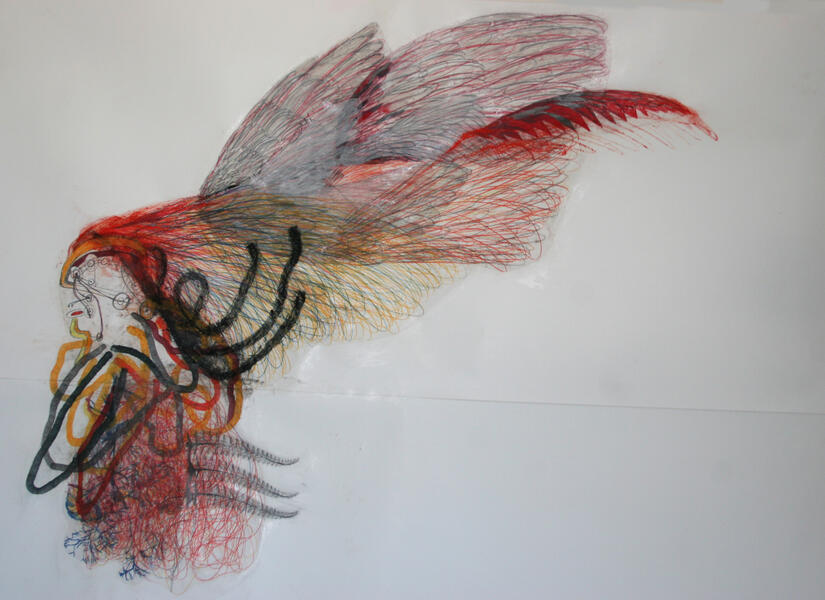 Anamesa2007 mixed media on paper 5 ft x 7 ft
Anamesa2007 mixed media on paper 5 ft x 7 ft -
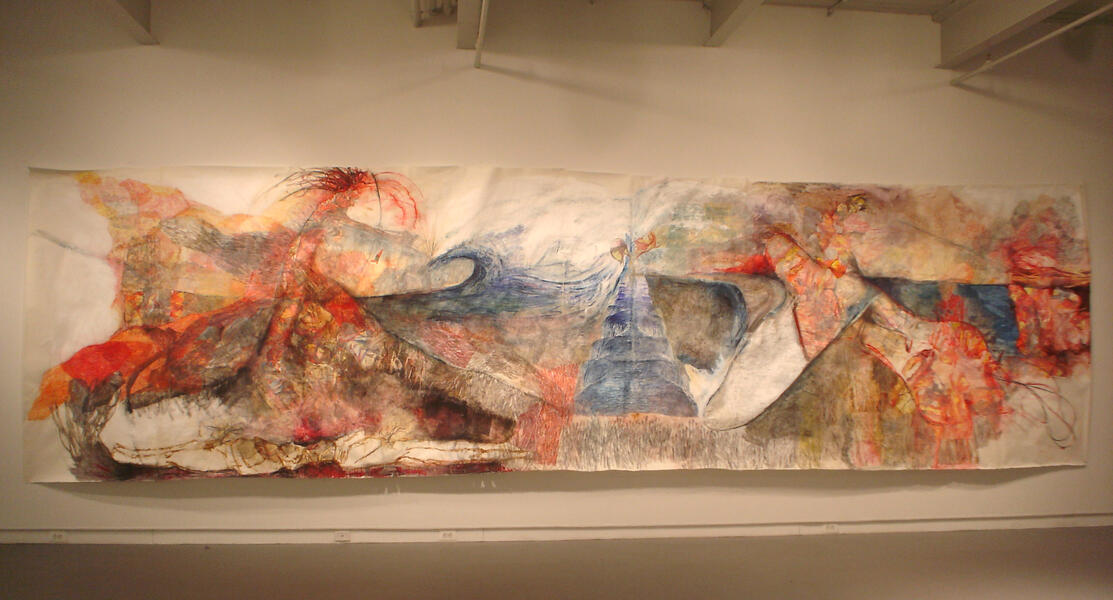 Circular Ruinsmixed media on paper 2017 8 ft x 30 ft
Circular Ruinsmixed media on paper 2017 8 ft x 30 ft -
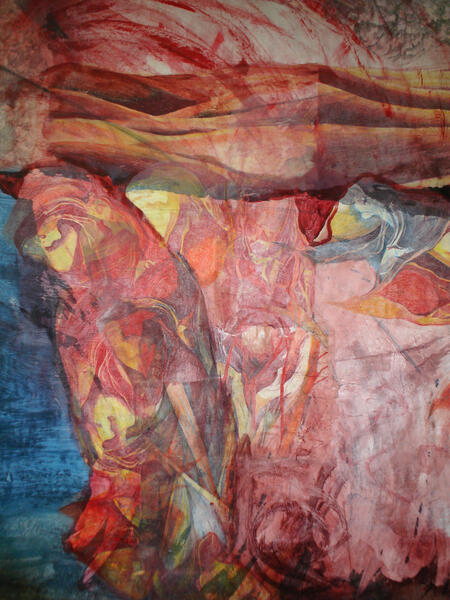 Circular Ruins (detail)mixed media on paper 2007 8 ft x 30 ft
Circular Ruins (detail)mixed media on paper 2007 8 ft x 30 ft -
 Circular Ruins (detail)mixed media on paper 2007 8 ft x 30 ft
Circular Ruins (detail)mixed media on paper 2007 8 ft x 30 ft -
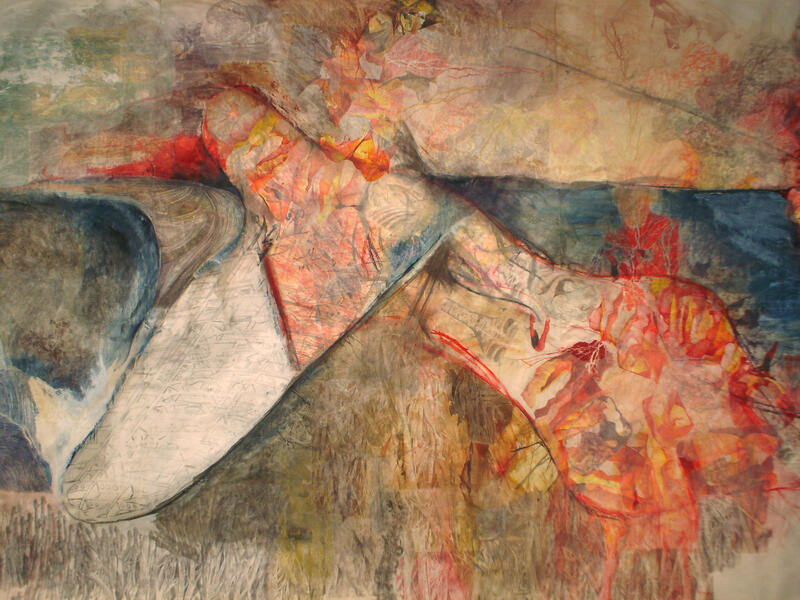 Circular Ruins (detail)mixed media on paper 2007 8 ft x 30 ft
Circular Ruins (detail)mixed media on paper 2007 8 ft x 30 ft -
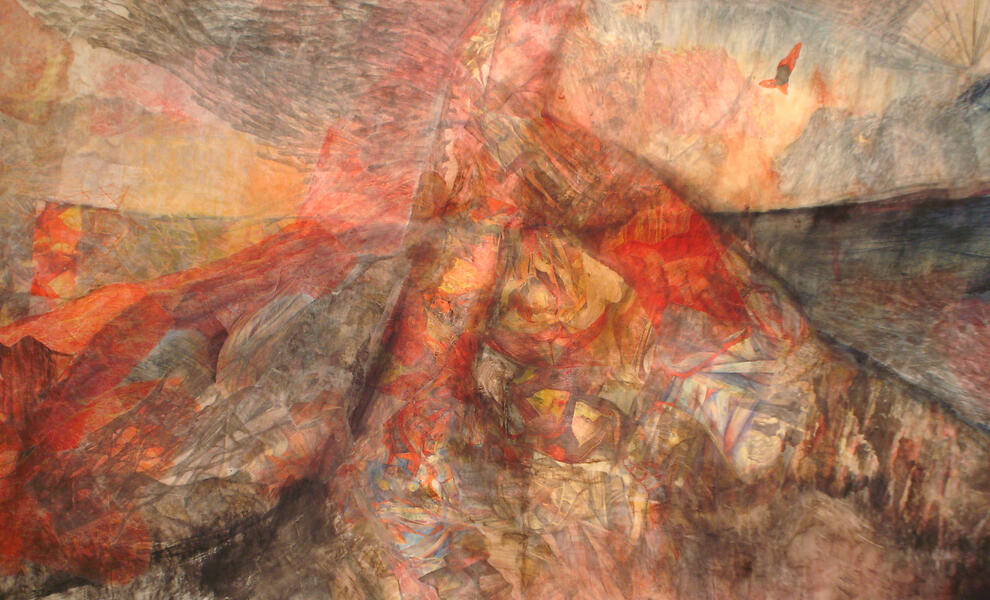 Circular Ruins (detail)mixed media on paper 2007 8 ft x 30 ft
Circular Ruins (detail)mixed media on paper 2007 8 ft x 30 ft -
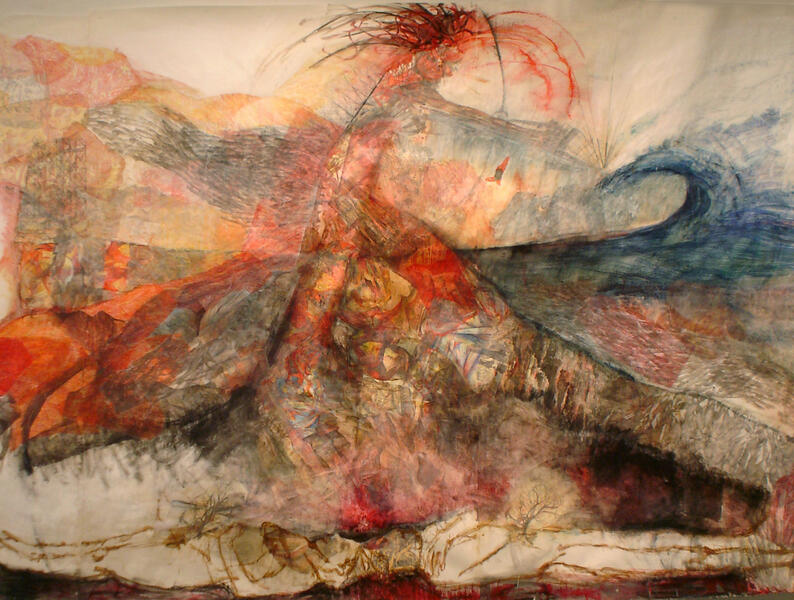 Circular Ruins (detail)mixed media on paper 2017 8 ft x 30 ft
Circular Ruins (detail)mixed media on paper 2017 8 ft x 30 ft
